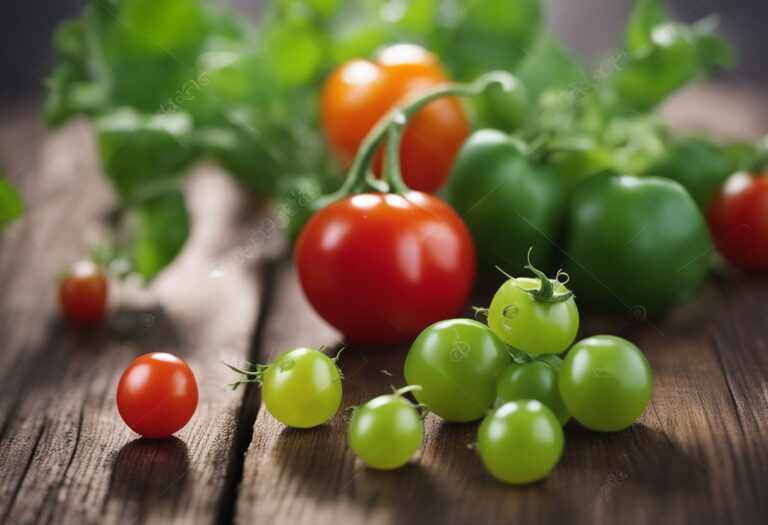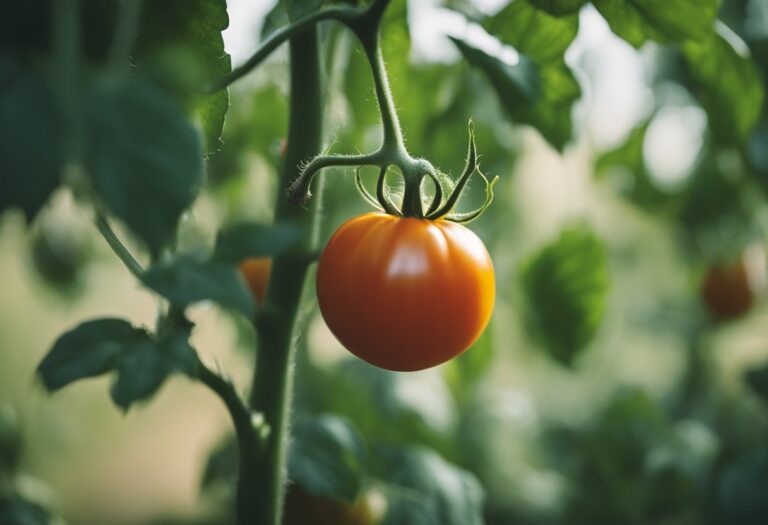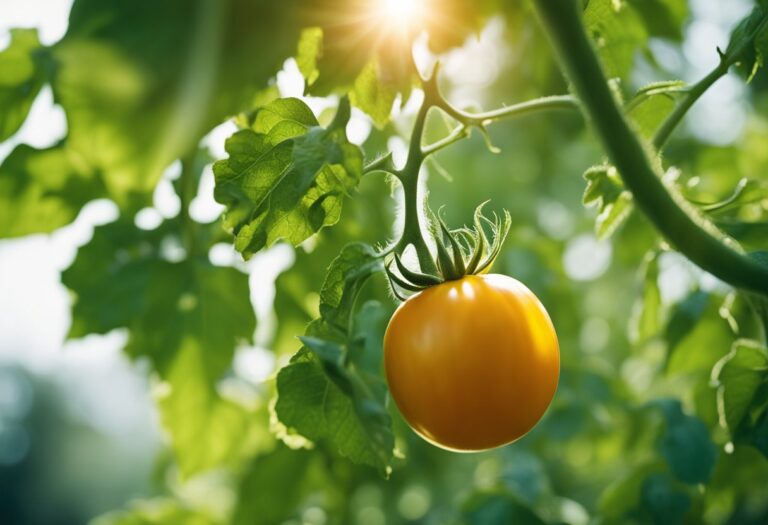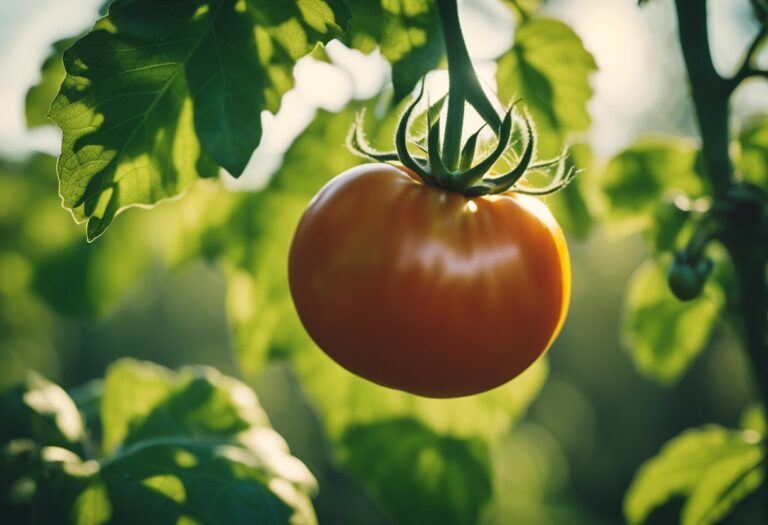Plum Tomatoes: A Guide to This Versatile Ingredient
Plum tomatoes, also known as paste tomatoes, are a popular variety of tomato that are cherished for their firm flesh, fewer seeds, and sweet yet tangy flavor. They are often used for making sauces, juice, and tomato paste. Plum tomatoes are oval, longer and narrower than other types of tomatoes, with less liquid pulp and seeds.

These versatile tomatoes have a diverse range of uses in the kitchen, from sauces to salads to soups. They can be grown in containers or in the garden, making them a great choice for gardeners with limited space. In this article, we will explore the basics of plum tomatoes, including how to cultivate and harvest them, as well as how to cook with them and their health benefits and uses.
Key Takeaways
- Plum tomatoes are oval, longer and narrower than other types of tomatoes, with less liquid pulp and seeds.
- They are often used for making sauces, juice, and tomato paste.
- Plum tomatoes are versatile and can be grown in containers or in the garden, and have a diverse range of uses in the kitchen.
The Basics of Plum Tomatoes

Defining Plum Tomatoes
Plum tomatoes, also known as paste tomatoes, are a type of tomato that is oblong or cylindrical in shape with a pointed end.
They are meatier and have fewer seeds than other tomato varieties, making them ideal for sauces, pastes, and canning. Plum tomatoes are also used in salads and sandwiches, and they are often roasted or grilled to bring out their sweetness.
Varieties of Plum Tomatoes
There are several varieties of plum tomatoes, including San Marzano, Roma, and Amish Paste. San Marzano tomatoes are considered the gold standard for Italian cooking and are known for their sweet, tangy flavor and low acidity.
Roma tomatoes are slightly larger than San Marzano tomatoes and have a firmer texture, making them ideal for sauces and pastes. Amish Paste tomatoes are a newer variety that is oblong in shape and has a deep red color. They are meaty and flavorful, making them a popular choice for sauces and canning.
Nutritional Profile
Plum tomatoes are a good source of vitamins A and C, potassium, and fiber. They are also low in calories, with one medium-sized plum tomato containing only 11 calories. Additionally, they are rich in lycopene, a powerful antioxidant that has been linked to a reduced risk of heart disease and certain types of cancer.
Plum tomatoes are a versatile and nutritious ingredient that can be used in a variety of dishes. Whether you’re making a homemade pasta sauce or adding them to a salad, plum tomatoes are a delicious and healthy addition to any meal.
Cultivating Plum Tomatoes

Plum tomatoes are a popular variety of tomatoes that are easy to grow and yield a bountiful harvest. Here are some tips for cultivating plum tomatoes successfully.
Ideal Growing Conditions
Plum tomatoes thrive in full sun and require at least 6-8 hours of direct sunlight per day. They prefer well-draining soil that is rich in organic matter. The ideal soil pH range for plum tomatoes is between 6.0 and 6.8. Additionally, plum tomatoes require regular watering to keep the soil consistently moist, but not waterlogged.
Planting Techniques
Plum tomatoes can be grown from seeds or seedlings. If starting from seeds, it is recommended to start them indoors 6-8 weeks before the last expected spring frost. Once the seedlings have grown to about 6 inches tall, they can be transplanted into the garden. When planting, make sure to space the plants about 24-36 inches apart to allow for proper air circulation.
Maintenance and Care
To promote healthy growth and prevent disease, it is important to keep the soil consistently moist and to fertilize the plants regularly. Mulching around the base of the plants can help retain moisture and prevent weeds from growing. Additionally, pruning the lower leaves of the plant can help improve air circulation and prevent disease.
Common Pests and Diseases
Plum tomatoes are susceptible to a variety of pests and diseases, including aphids, whiteflies, and blossom end rot. To prevent these issues, it is important to inspect the plants regularly and take action at the first sign of a problem.
This may include using insecticidal soap or neem oil to control pests, or adding calcium to the soil to prevent blossom end rot.
Harvesting and Storing
Plum tomatoes are a versatile and delicious ingredient in many dishes. To make the most of their flavor, it’s important to harvest and store them properly. Here are some tips to help you do just that.
When to Harvest
Plum tomatoes are usually ready to harvest when they reach their mature color, which can vary depending on the variety. Generally, they will be a deep red color. Another way to tell if they’re ready is to gently squeeze the tomato. If it gives slightly, it’s ready to be picked.
How to Harvest
When harvesting plum tomatoes, it’s important to use a sharp pair of scissors or pruning shears to avoid damaging the plant. Cut the stem of the tomato just above the fruit, leaving a small piece of stem attached. This will help to prevent the tomato from rotting.
Storage Tips
To store plum tomatoes, it’s important to keep them in a cool, dry place. They can be stored on the counter if they’re going to be used within a day or two. If you need to store them for longer, they can be kept in the refrigerator. However, refrigeration can sometimes affect the flavor and texture of the tomato, so it’s best to use them as soon as possible.
Another option for storing plum tomatoes is to freeze them. To do this, simply wash and dry the tomatoes, then place them in a plastic freezer bag and freeze. They can be used later for making sauces, soups, or stews.
Remember, harvesting and storing plum tomatoes properly will help to ensure that they stay fresh and flavorful for as long as possible.
Cooking with Plum Tomatoes
Plum tomatoes are versatile and can be used in various dishes due to their firm texture and rich flavor. Here are some preparation methods and recipe ideas to help you make the most of your plum tomatoes.
Preparation Methods
Plum tomatoes are easy to prepare and can be used in various ways. They can be roasted, grilled, or sautéed. To roast plum tomatoes, cut them in half and place them on a baking sheet.
Drizzle with olive oil and sprinkle with salt and pepper. Roast in the oven at 425°F for about 30 minutes or until tender. To grill plum tomatoes, cut them in half and brush with olive oil. Grill on medium heat for about 5 minutes or until charred. To sauté plum tomatoes, heat olive oil in a pan and add sliced tomatoes. Cook for about 5 minutes or until tender.
Recipe Ideas
Plum tomatoes are a great addition to many dishes, from salads to soups to pasta. Here are some recipe ideas to inspire you.
- Caprese Salad: Slice plum tomatoes and fresh mozzarella cheese. Layer them on a plate and sprinkle with fresh basil leaves. Drizzle with olive oil and balsamic vinegar. Season with salt and pepper.
- Tomato Sauce: Plum tomatoes are perfect for making tomato sauce. Sauté garlic and onion in olive oil. Add chopped plum tomatoes and cook until they break down. Season with salt, pepper, and fresh herbs. Serve over pasta.
- Bruschetta: Toast slices of bread and top with chopped plum tomatoes, garlic, fresh basil, and olive oil. Season with salt and pepper.
- Gazpacho: In a blender, combine chopped plum tomatoes, cucumber, red bell pepper, garlic, red onion, and bread. Blend until smooth. Add olive oil and vinegar. Season with salt and pepper. Chill and serve.
- Tomato Soup: Sauté garlic and onion in olive oil. Add chopped plum tomatoes and chicken broth. Simmer until tender. Blend until smooth. Season with salt, pepper, and cream.
Health Benefits and Uses
Plum tomatoes are a great source of vitamins and minerals that are essential for maintaining good health. They are low in calories and high in fiber, making them an ideal food for those who are trying to lose weight or maintain a healthy weight.
These tomatoes are also rich in potassium, which is important for maintaining fluid balance, muscle contraction, and nerve function. A single plum tomato can contain up to 9% of the daily recommended intake of potassium.
Plum tomatoes are also a good source of vitamin C, which is important for maintaining a healthy immune system. They also contain vitamin A, which is essential for maintaining healthy eyes and skin.
In addition to their nutritional benefits, plum tomatoes are also versatile in the kitchen. They can be used in a variety of dishes, including salads, soups, sauces, and stews. They can also be roasted or grilled for a delicious side dish.
Frequently Asked Questions
What’s the difference between Roma and plum tomatoes?
Roma and plum tomatoes are often used interchangeably in recipes. However, Roma tomatoes are a specific type of plum tomato that is more oblong in shape and has a thicker, meatier texture. Plum tomatoes, on the other hand, can refer to any tomato variety that is shaped like a plum.
What nutritional benefits do plum tomatoes offer?
Plum tomatoes are a great source of vitamins A and C, as well as potassium and fiber. They are also low in calories and fat, making them a healthy addition to any diet.
Where can I find plum tomatoes for purchase?
Plum tomatoes are widely available at most grocery stores and farmers markets, especially during the summer months when they are in season. Look for firm, unblemished tomatoes with a deep red color.
Can you suggest a good substitute for plum tomatoes?
If you can’t find plum tomatoes, you can substitute them with other tomato varieties like beefsteak or heirloom tomatoes. However, keep in mind that the texture and flavor may be slightly different.
What are some popular recipes that use plum tomatoes?
Plum tomatoes are a staple ingredient in many Italian dishes, including pasta sauces and pizzas. They are also commonly used in salads and salsas. One popular recipe is Caprese Salad, which consists of sliced plum tomatoes, fresh mozzarella, and basil leaves.
How do I grow plum tomatoes from seeds?
To grow plum tomatoes from seeds, start by planting the seeds in a seed-starting mix in a warm, sunny location. Keep the soil moist and transplant the seedlings to larger containers as they grow. Once the seedlings are large enough, transplant them to a sunny spot in your garden or in a large container. Water regularly and fertilize with a balanced fertilizer.





